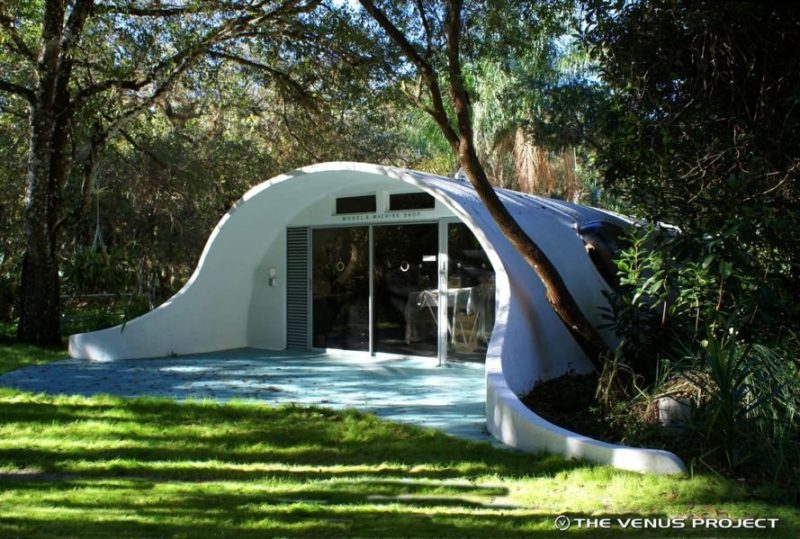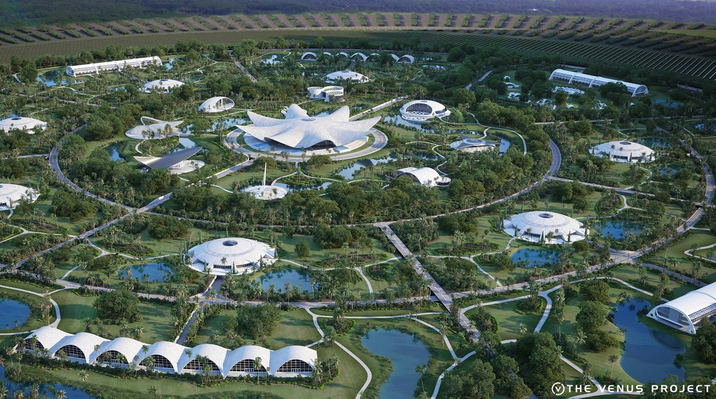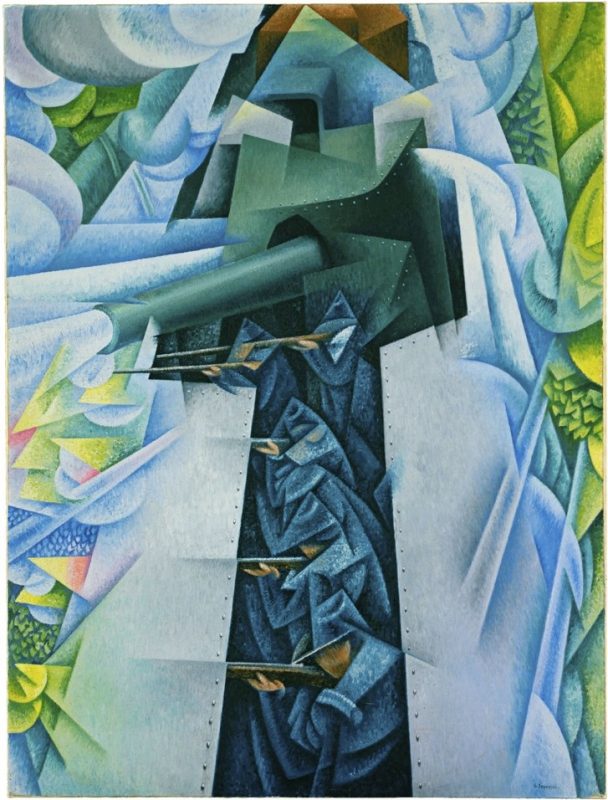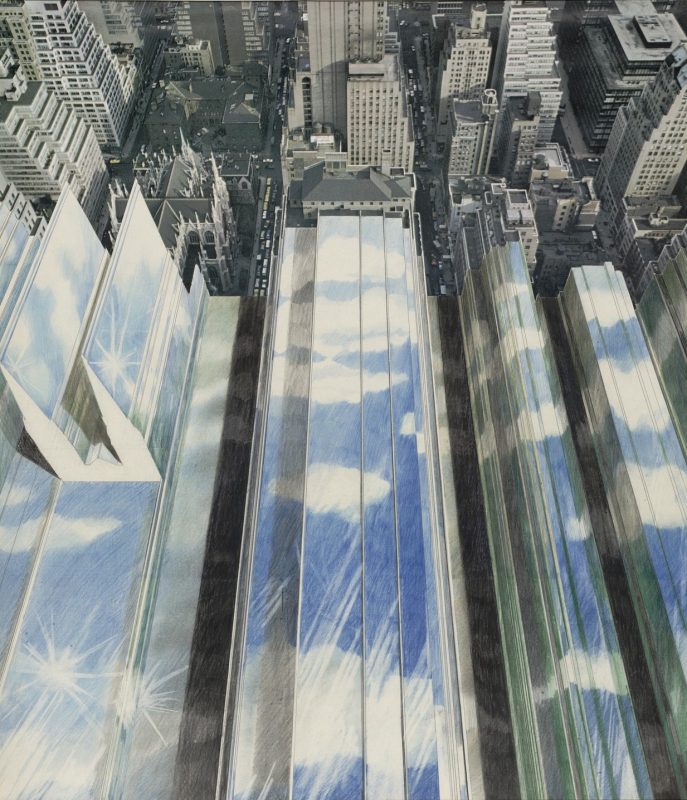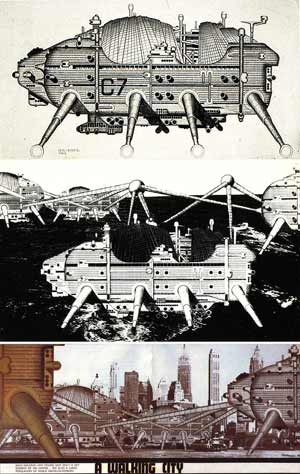Matters of Utopia
Posted on December 16, 2019Imagine a shady tree hammock with a dense canopy of long spanning Live Oak branches. Mixed among the canopy are a plethora of Sabal palms and plantain trees, along with the occasional low growing shrub and fern. Suddenly, a clearing appears in this tropical forest—manicured green grass and a futuristic, stark white and dome-shaped structure come into view.
You don’t have to search much further than South Florida to find a scene like the one described above. A building like this exists in the community of Venus, Florida, and is an example of a domicile as envisioned in The Venus Project, created by self proclaimed futurist Jacque Fresco and associate Roxanne Meadows.
The Venus Project is a beautifully ambitious proposal for a radically different kind of civilization than our current one, and it shares many similarities with the proposed models in “Inventing the Future: Postcapitalism and a world without work”. The Venus Project plan proposes a switch from capitalism to a Resource based economy, as well as utilizing the most current technological and scientific advances to provide a high standard of living for all people on Earth. Ultimately, it suggests eradicating human labor in favor of machine labor, thus allowing humanity to pursue intellectual and cultural interests instead.
Jaque Fresco and his team have been advocating for this new technological society for decades, giving lectures and presentations at universities and centers all over the world—they have gone so far as to build some of the structures from their plan, and even commit to living and working within those spaces. If Srnicek and Williams have put forth a call to action in their book urging the people to take matters into their own hands, then it can be said that The Venus Project has already retroactively answered this call with their vision of radical architecture—but I wonder, realistically speaking, to what extent can these Utopic models be viable solutions?
The concept of a technologically driven utopia has a long and winding history, with several different iterations emerging as science has advanced; (from these many iterations I’ll be mentioning a select few that stood out to me personally during my studies in architecture). In the early 20th century, frontrunner to the Italian Futurists, Antonio Sant’Elia, wrote “The Manifesto of Futurist Architecture” and featured a now famous illustration of “La Citta Nuova” (the new city)—which envisioned a new and fully automated civilization, a city that would run like a cohesive machine and one where none would have to labor.
- Antonio Sant’elia, “La Citta Nuova” (1912-1914)
- Gino Severini, “Armored Train in Action” (1915)
The Futurist movement transcended through realms of art, design and architecture, but it is worth noting that it’s core principles came out of a war-torn world in the midst of WWI; ideally to diminish loss of life by replacing soldiers with machines. As a group they called themselves ‘futurists’ and had dreams of a perfectly mechanized and painless world. Unfortunately, the technology just wasn’t advanced enough and the political landscape too unpredictable for their movement to make significant headway.
Later in the 20th century another group of Italians, this time it was the architecture group Superstudio in the 1960’s, also speculated on what the city of the future would be like. They played within the realm of radical design and architecture, at times critiquing the advancement of technology and at others embracing it fully. However, they never actually built any structures because their designs were too outlandish and impractical—effectively only functioning in a still distant future. Around the same time the counterculture group Drop City, actually began building their own geodesic dome communities in 1965, based upon the principles of Buckminster Fuller; but while they were bold, these attempts were mostly sporadic and eventually died down as well. Unfortunately, yet again, it seemed that the technology of the time and political landscape were not sophisticated enough to accept such radical designs.
- Superstudio, “The Continuous Monument” (1969)
- London studio Archigram, “The Walking City” (1964)
In the present, groups continue to live out their visions of a high-tech future (much like The Venus Project, with it’s futuristic dome and interior that looks like a film set for a movie of The Jetsons). Truthfully, we have never been closer to experiencing what an advanced and fully automated society would be like. In fact, Jacque Fresco has been claiming that our science, medicine and technology are sufficiently advanced to achieve something like The Venus Project, (even since the time of its inception in the 1970’s)—so that begs the question, what is holding us back?
I suppose that part of the designer’s role is to speculate about possible futures, but in this case a look into history, and even present examples, reveals that utopian models tend to fall apart when encountering the realities and roadblocks of the real world. Could it be that such a model as is proposed in “Inventing the Future: Postcapitalism and a world without work,” despite all of it’s beautiful intentions, will never be viable for human civilizations? And if that is a very real possibility, is it then unreasonable for designers to put forth such brazen calls-to-action to the public?
-MD
- Drop City
Sources & Links:
“Inventing the Future: Postcapitalism and a world without work”, Srnicek and Williams
The Venus Project – https://www.thevenusproject.com/the-venus-project/
The New York Times on Sant’Elia – https://www.nytimes.com/1986/02/21/arts/architecture-antonio-sant-elia.html
MOMA on Futurist Art – https://www.moma.org/collection/works/79418
MOMA on Superstudio – https://www.moma.org/collection/works/938
The Guardian on Archigram – https://www.theguardian.com/artanddesign/2018/nov/18/archigram-60s-architects-vision-urban-living-the-book
Buckminster Fuller Institute on Drop City – https://www.bfi.org/dymaxion-forum/2015/09/drop-city-50-years-later
